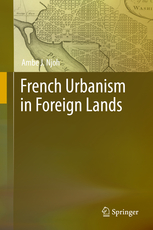French Urbanism in Foreign Lands

This book describes some elements and purposes of French urban planning models in foreign territories. The author seeks to promote understanding of the channels or conduits employed in efforts to diffuse these models.
The book is organized in nine chapters. The first chapter explains the implications of French colonial urbanism. Concepts such as acculturation and assimilation are described. Moreover, the author describes categories of power in built space that played a key role in expressing colonial aims, which included manipulation and segregation. For example, French colonialism encouraged structures with an exaggerated scale such as cathedrals, chapels, hospitals, colonial government buildings, and monuments, which were seen as instruments of “domination” and “intimidation”. Also explained are the historical channels for diffusing French urbanism, such as colonial governments, educational and research institutions, professional and scholarly associations, and international development agencies and consultants.
In Chapters 2–8 the author describes cases of French urban planning models around the world, organized by geographic region. These explain how colonialism served as a conduit for transmitting French urbanism to the region known as New France in North America. French colonial architects and engineers melded practices with which they were familiar and those they acquired from their host environment to produce the unique architectural style that came to be known as the French colonial style, which started in French colonial Louisiana in 1699. Elements related to the French colonial architectural style are the French Creole plantation house, Creole cottage and Creole townhouse in North America and the Caribbean.
French urbanism planning models were not only transmitted to countries through colonialism. Although France did not have a colonial influence in Latin America, this region was significantly influenced by the French urban planning. Three specific factors facilitated the diffusion of French urbanism in the region:
· The region’s abundant supply of land, which made the region ideally suitable as a laboratory for testing the workability of Eurocentric theories of spatial order in eighteenth and nineteenth centuries.
· An abundance of financial resources that enabled the region to meet the high cost of hiring foreign consultants.
· The availability of effective diffusion mechanisms. Groups of professionals served as some of the most effective enablers in the complex process of transferring French urbanism to the region.
The three cities in Latin America that were highly influenced were Buenos Aires, Rio de Janeiro and Caracas. The features of French design, planning ideas and principles that affected Latin American cities included: avenues and nodes constituting communication arteries, new railway stations, new squares or “plazas”, and public meeting places. However, the element that generated major interest among authorities in Latin America was the tree-lined boulevard, designed by Georges-Eugène Haussmann.
As for the Middle East, the region has a rich history of human settlements in particular and built space in general that predated the French colonial enterprise. However, there are some marks of French urbanism in this region, especially in Syria (in Aleppo and Damascus) and in Lebanon (in Beirut). During the time between the world wars, France played the role of the main protector of Christianity in the two countries. That role was manifested in built space through the construction of churches, cathedrals and mission schools.
The last chapter, “Continuity and change in French International Urbanism”, seeks to show how French notions of spatial and physical design continue to affect contemporary urbanization in erstwhile colonial nations, and to demonstrate that more continuity than change has characterized French overseas urbanism. However, it is erroneous to consider colonialism the only conduit through which French urbanism has been exported abroad. This chapter also describes the phenomenon of the “boomerang effect in French colonialism”, which explains, paradoxically, that tools the French had developed to socially control urban areas in the colonies are increasingly employed for similar purposes in France.
Book note prepared by Lina María Rosales
Search the Book notes database
Our Book notes database contains details and summaries of all the publications included in Book notes since 1993 - with details on how to obtain/download.
Use the search form above, or visit the Book notes landing page for more options and latest content.
For a searchable database for papers in Environment and Urbanization, go to http://eau.sagepub.com/

